
Atlas F1 Technical Writer
The Hungarian Grand Prix was all about cooling devices on the cars, in an attempt to withstand the high temperatures that hit the track come race day. Craig Scarborough reviews each team and its cooling solutions
Before the weekend started, heavy rain had fallen and threatened to interrupt the weekend. The nearby Danube River was filling up and a major disaster along the lines of the floods seen in Germany and the Czech Republic were forecasted for the area. Although rain never actually fell during a session, its effect made an impact on the track and the teams' preparation.
The effect of the climate hotting up over the weekend brought good and bad news. It was good that the usual dust was not being blown onto the track, as the ground was wet and the unusually lush green grass kept the sandy soil in place.
The bad news was that cooler temperatures on Friday destroyed the Michelin runners' programmes - the track was cold and what little rubber that the track had built up over the year was washed away, leading to a very slippery surface, even without the dust. On Friday many teams lost time chasing their setup and adjusting for the gripless conditions. Most drivers went off the circuit at some stage and many lost valuable track time as a result.
Michelin had opted for the harder of the their compounds and their runners were almost out of the top ten on Friday, so overall this was a Bridgestone weekend with even the Bridgestone customer teams enjoying a competitive run.
By the time qualifying arrived, the teams were still taking guesses on setup and on whether to use fresh or scrubbed tyres. For the race, all the teams had to adopt extra cooling precautions to keep the engines and drivers cool.
Team by Team
Ferrari
Cooling: the usual F2002 setup of a small outlet on the top edge of the sidepod was employed, but also the fairing covering the exhaust pipes was cut back to provide a clearer passage for the heated air from the sidepods. A small scoop was added to the hatch above the driver feet to help cool the drivers.
Come Saturday's qualifying session, Rubens Barrichello opted for scrubbed tyres and made fine-tuning changes to the car during the session. Michael Schumacher ran on fresh tyres and felt it was not the right direction to go for; he only completed three runs, preferring to save tyres for the race.
In the race Barrichello, on the clean side of the grid, had the better start than Schumacher. "I couldn't believe how good my start was," the Brazilian said. "I just tried to stay cool and not brake too late." He was then trying to conserve his tyres but found them able to last. Schumacher, by contrast, felt the start was "like driving on ice." But, with the huge advantage the Ferraris held over the rest of the field, both drivers could afford to preserve their cars and slow down their pace.
Williams
Cooling: the new aero setup does allow for Chimneys but Williams prefered not to use them in place of the small winglets, and instead a small outlet was formed into the sidepods between the winglets and above the flip up to vent hot air from the sidepods.
Williams ran the curved front wing and mid wing for extra downforce at Hungary. The exhaust exit covers also appeared to be raised higher from the sidepods than before, although not as dramatic as Ferrari's.
Schumacher was also ahead in qualifying, despite finding the car difficult to drive. The German had an off on one run, and he tried dramatically different set ups from the base line set up from Friday. He improved the car but was never in contention despite the hotter weather suiting the Michelins more than before. "I have never made so many changes to my car than this during a qualifying session," he later said. Montoya too was adventurous on his set up but never found the time in the car as Ralf Schumacher had done.
In the race, Ralf had a better start than his brother and briefly challenged for second, but thereafter fell back, only keeping pace towards the end of the stint when his tyres had come back in. Montoya was involved in two incidents - the first one at the start, when several drivers bumped into each other, causing damage to his car and leading to some understeer.
This allowed McLaren's Kimi Raikkonen to challenge Montoya and the Colombian slid off the track, further damaging the bargeboards and sidepod's fins. He pitted for new nose and to have some of the broken bodywork removed but the car's handling deteriorated, and he found the car sometimes impossible to drive.
McLaren
Cooling: the outlets above the flip ups were opened up, and a small triangular section ahead of these was again cut out to improve the cooling flow.
Friday was good for Kimi Raikkonen, who found a setup he liked, while David Coulthard said it was tricky to find the right balance, which lead to a spin and a resulting puncture. As he toured back to the pits, his engine overheated and needed attention, which kept him from much more running.
Coulthard was also disappointed in qualifying as he couldn't get the Michelins to work even in the warmer weather and he couldn't understand where the problem stemmed from. Raikkonen also struggled but suffered more from traffic than poor balance.
Sunday's hotter weather suited the McLarens and the tyres. Once Raikkonen had made a good start and fought past Montoya and the Renaults, he was able push on the clear track, but it was by then too late. Conversely Coulthard lost out amongst the bumping at the start and found the car inconsistent and nervous.
Renault
Cooling: larger openings ahead of the flip ups were used by Renault.
The asymmetric aerodynamic set up was again used by Renault this weekend, with one side of the sidepod featuring a winglet and the other a flip-up. The new, recently introduced floor features a revised fin ahead of the sidepod - the smaller shape is disguised by the part no longer being painted yellow and instead is left in raw carbon fibre. Additionally, the new floor has much larger fences placed on the floor inside the rear wheels.
Jenson Button felt he had lost some the of pace he found on Friday morning as he was lacking grip, Jarno Trulli also felt a lot had to be done before qualifying. A new specification engine for qualifying improved the lap times and Trulli's engineers also improved the car step by step during the session. Button was unsure why he wasn't able to get the same pace out of the car as his teammate, and ended up three places behind.
Trulli's sixth on the grid was lost amongst the trouble at the start and a loss of grip from the front left on his third set of tyres kept him from the points. Button's better start was lost with tyre troubles when blistering lead to oversteer, then he put the right-rear wheel on the kerb and spun off into the gravel.
Sauber
Cooling: Sauber used the larger of the their chimneys placed on top of the sidepods to cool the cars for the hotter weather.
Sauber adopted Ferrari-like exhaust exits on the Petronas badged Ferrari engine, but although the setup matched the Ferrari's appearance, the philosophy is different. Ferrari actually place an enlargened tail pipe inside the fairing to aim the exhaust gas flow higher up over the rear wing mount, whereas Sauber have a barely modified exhaust pipe and use the fairing to extract hot air from the sidepod aided by the flow from the exhaust pipe.
Felipe Massa was happier with the car but still managed to join Heidfeld in leaving the circuit and damaging his car.
In Saturday's timed session, Heidfeld felt he had too much understeer and made a big change to the setup for his last run - "it made a significant difference," he said, and so he was very happy with eighth place. Massa also had understeer but was able to finish in seventh. Both drivers had strong races but ultimately lost out in the pit sequence to the recovering McLaren.
Jordan
Cooling: the ever present Chimneys were opened up and also a panel in front of the exhaust pipes was removed on the top of the sidepods to improve cooling.
The front wing endplates featured a revised leading edge to the horizontal lip, which has been cut back at 45 degrees. The smaller mid wing placed on the roll structure was reintroduced for more downforce.
BAR
Cooling: the new aero package introduced mid season does away with BAR's trademark exits on the flanks of the sidepods and uses chimneys instead - their inner trailing edges are cutaway and also a small slot was cut into the sidepod to help race day cooling.
Problems continued on Saturday, with Panis experiencing a number of electronic problems and Villeneuve a mechanical problem the end of morning practice. This meant the Canadian didn't finalise his setup for qualifying and ended up spinning off in the timed session.
Yet more problems carried on into the race, when Panis had to lift off towards the end of the race with an oil pressure problem and Villeneuve posted the first retirement with a seized transmission.
Jaguar
Cooling: the outlets formed by the flip ups were fully opened up and additionally a small panel was removed from the side of the sidepod and a chimney was added to one side for the race, the chimney carried small winglets usually seen mounted on the sidepod tops.
Pedro Del Rosa worked hard on Friday to get through a lot of set up work, which resulted in more grip, but he lost a front wing in an incident with Coulthard. Eddie Irvine found the R3 very twitchy, suffering from oversteer and a throttle response problem. Qualifying brought traffic for both drivers and Irvine listed all sorts of issues, ranging from oversteer to understeer in addition to the traffic problems.
De la Rosa announced this was "a boring race" and felt the car was OK with no tyre problems. Irvine found a big improvement in the car's handling in time for the race, but then a misfire left him little choice but to retire on lap 24.
Toyota
The car sported the Imola/Monaco Wing package to provide the TF102's basic wing package with as much extra downforce as possible.
Mika Salo was happy with the car on Friday while Allan McNish felt the car was oversteering aggressively and had no consistency. He also had an electronics problem in the afternoon session. As expected, the team struggled in qualifying and Salo reported a lack of grip and not enough downforce. Meanwhile McNish said his first run was pretty good, but found increasing understeer as the session went on.
A double finish was a reward for the team with only pit problems upsetting the result - Salo being penalised for a dangerous manoeuvre and McNish running into problems when selecting gear at his pitstop. Salo's bad day was also worsened by the onboard fire extinguisher going off and spraying foam everywhere.
Minardi
Debutante Anthony Davidson covered the greatest number of laps in Friday's two sessions, despite a gearbox problem sending him off the track at the end of the morning session. Mark Webber completed a normal Friday programme in order to decide on the soft Michelin tyre. Webber saved a set of these for the race by only completing three runs in qualifying. Davidson qualified last, in 20th.
Unreliability only affected Webber's drink bottle in the race and he also made a mistake coming into the pits - braking a little bit too late and hitting a team member. Davidson pushed harder and harder until he overstepped the limit, and when he got onto a slightly dusty part of the track while being overtaken, he lost the back end.
As the teams completed their usual preparations and weekend programmes, the biggest issue that faced the teams was the weather. The usual high temperatures did not greet the teams until later on Saturday and even then only on Sunday did the thermometers reach the heights expected in Budapest.
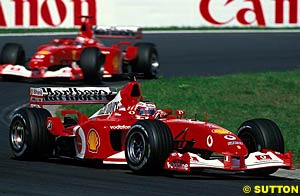 On Friday morning, both Ferrari drivers used one set of tyres and were happy with the F2002. Traction control work was a high priority despite the drivers sitting out half of the session. "The track was dirty and every time our drivers went out, it seemed as though they were driving a different car," technical director Ross Brawn explained. "It was difficult to make changes to the car as the track conditions changed a great deal and also because of cars going off the track. This also made it difficult to run our tyre assessment programme."
On Friday morning, both Ferrari drivers used one set of tyres and were happy with the F2002. Traction control work was a high priority despite the drivers sitting out half of the session. "The track was dirty and every time our drivers went out, it seemed as though they were driving a different car," technical director Ross Brawn explained. "It was difficult to make changes to the car as the track conditions changed a great deal and also because of cars going off the track. This also made it difficult to run our tyre assessment programme."
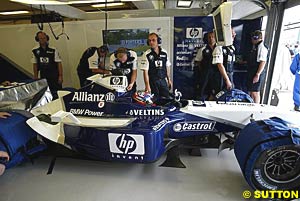 Friday started good and bad, Ralf Schumacher was up to third and Juan Pablo Montoya spun off and was stuck in the gravel at the end of the session. Setup-wise, the team were struggling quite a bit with the balance but at least had a decision on tyre choice for the race.
Friday started good and bad, Ralf Schumacher was up to third and Juan Pablo Montoya spun off and was stuck in the gravel at the end of the session. Setup-wise, the team were struggling quite a bit with the balance but at least had a decision on tyre choice for the race.
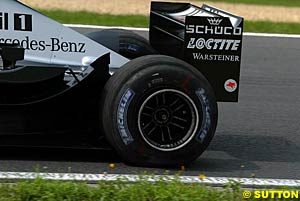 As well as changes to the car, McLaren have made changes to their staff: long time McLaren man Neil Oatley will assume overall responsibility for engineering; poached from Arrows, Mike Coughlan will join McLaren as Chief Designer working under Adrian Newey's technical direction; and John Sutton - who joins from Ferrari and Williams as transmission designer and was credited for Ferrari's gearbox success - will help McLaren with their new gearbox, which they have struggled with.
As well as changes to the car, McLaren have made changes to their staff: long time McLaren man Neil Oatley will assume overall responsibility for engineering; poached from Arrows, Mike Coughlan will join McLaren as Chief Designer working under Adrian Newey's technical direction; and John Sutton - who joins from Ferrari and Williams as transmission designer and was credited for Ferrari's gearbox success - will help McLaren with their new gearbox, which they have struggled with.
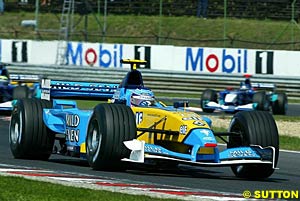 The rear wing endplates once more featured extensions to cover the inside of the rear tyres - the extension could perhaps allow a small wing to be added above the gearbox should the team look for more rear downforce. The endplates also featured a McLaren-style cut out between the second and third elements to maintain enough flow to the outer edges of the wing when the elements are set at steep angles.
The rear wing endplates once more featured extensions to cover the inside of the rear tyres - the extension could perhaps allow a small wing to be added above the gearbox should the team look for more rear downforce. The endplates also featured a McLaren-style cut out between the second and third elements to maintain enough flow to the outer edges of the wing when the elements are set at steep angles.
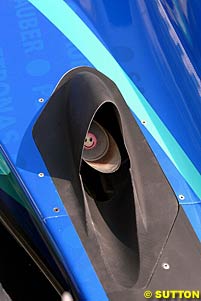 As with most teams, one driver struggled while the other was happy with the car. In Sauber's case, it was Nick Heidfeld that had problems. "All through the morning session I was struggling to get the car balanced, and new tyres tended to make it understeer more," he said. While pushing for a faster lap in the afternoon, he ran wide at the chicane and into the wall, badly damaging the car and ending his session.
As with most teams, one driver struggled while the other was happy with the car. In Sauber's case, it was Nick Heidfeld that had problems. "All through the morning session I was struggling to get the car balanced, and new tyres tended to make it understeer more," he said. While pushing for a faster lap in the afternoon, he ran wide at the chicane and into the wall, badly damaging the car and ending his session.
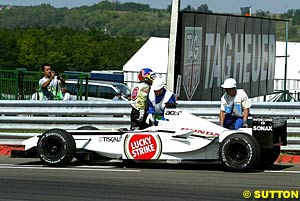 Jacques Villeneuve damaged his car when he spun off on Friday and had to sit out most of the session while the floor and the bargeboards were replaced. Olivier Panis also compromised his track time with yet another a gearbox oil leak and a smaller problem with the throttle.
Jacques Villeneuve damaged his car when he spun off on Friday and had to sit out most of the session while the floor and the bargeboards were replaced. Olivier Panis also compromised his track time with yet another a gearbox oil leak and a smaller problem with the throttle.
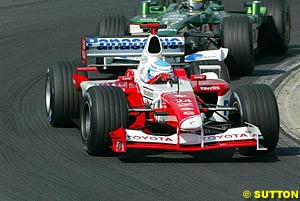 Cooling: Toyota used the later specification sidepod's outlets, where the top edge of the sidepods is flat and not rolled up as on the launch car. All new bargeboards were run in the race, with a smaller profile to allow more cooling air to the sidepods. The size of the sidepod inlet was reduced by the addition of a small fillet bonded to the lower edge of the opening.
Cooling: Toyota used the later specification sidepod's outlets, where the top edge of the sidepods is flat and not rolled up as on the launch car. All new bargeboards were run in the race, with a smaller profile to allow more cooling air to the sidepods. The size of the sidepod inlet was reduced by the addition of a small fillet bonded to the lower edge of the opening.
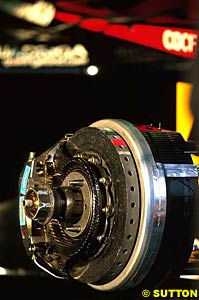 Cooling: Minardi used their usual chimneys without the extra flip-up added. For the brakes they have adopted the extra Toyota\Jordan type duct to cool the calliper pistons on the outer face of the disc.
Cooling: Minardi used their usual chimneys without the extra flip-up added. For the brakes they have adopted the extra Toyota\Jordan type duct to cool the calliper pistons on the outer face of the disc.
Please Contact Us for permission to republish this or any other material from Atlas F1.
|
Volume 8, Issue 34
Atlas F1 Exclusive
Davidson's Debut Diary
Ann Bradshaw: View from the Paddock
Hungarian GP Review
The 2002 Hungarian GP Review
Hungarian GP - Technical Review
The Two-Car Team
Those Pit Babes
Stats Center
Qualifying Differentials
SuperStats
Charts Center
Columns
Season Strokes
Elsewhere in Racing
The Grapevine
> Homepage |